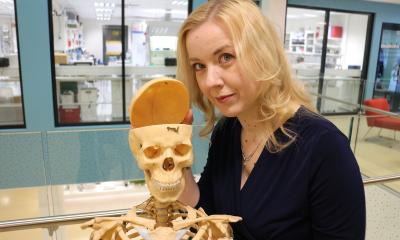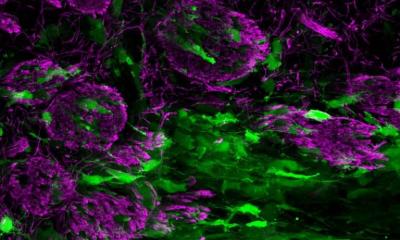News • Malignant infantile brain tumours
Epilepsy drug inhibits brain tumour development
Medication prescribed for a certain type of epilepsy may offer a new method for treating malignant infantile brain tumours.

A specific mTOR inhibitor has the ability to cross the blood–brain barrier to both reach and attack the tumour at source. This has been demonstrated by researchers from Uppsala University, in collaboration with US and UK colleagues, whose research has now been published in the scientific journal Cell Stem Cell.
Approximately 100 children suffer infantile brain tumours in Sweden each year. The most common type of malignant brain tumour in infants and children is medulloblastoma. Radiation therapy is part of the standard treatment for medulloblastomas and modern radiation therapy has saved the lives of many children suffering from these often aggressive cancers; however, as it often comes with serious side effects for healthy brain tissue, it is seldom prescribed for infants. Although a presumably better solution would be to give more targeted treatment, in order to establish such a therapy it would naturally need to be proven to be both more effective and come with fewer side effects than current treatments.

Image source: Unsplash/Ryan Quintal
Many infantile medulloblastomas are amplified by MYCN, an oncogene that drives tumour growth and metastasis to the spinal column, leading to a very poor prognosis. In the study in question, the researchers cultivated a particular type of neural stem cell and were able to demonstrate that MYCN was quickly able to turn these into cancer cells. This suggests that these cells are likely to be the origin of infantile medulloblastomas.
MYCN activity is controlled by a signal in what is known as the Sonic Hedgehog pathway, which is involved in the normal development of the brain but is upregulated in medulloblastomas. Although there are a number of drugs available today that inhibit this signal pathway, none have proven effective in children with brain tumours, who often experience serious side effects such as bone growth problems.
“I initially tested whether Sonic Hedgehog pathway inhibitors could knock out the tumour cells, but without success. The cells attacked another protein instead, Oct4, and another signal pathway called the mTOR pathway, making the tumour more aggressive,” explains Matko Čančer, a researcher at Uppsala University’s Department of Immunology, Genetics and Pathology, who conducted the laboratory studies.
This is a very promising discovery and, if this precision medicine works on young children with medulloblastomas that do not respond to conventional treatment, it would of course be fantastic
Fredrik Swartling
Matko Čančer was later able to show that Oct4 and the mTOR signal pathway interact in infantile brain tumours with a very poor prognosis. When he then tested a number of drugs with the ability to inhibit this pathway, he saw that the brain tumour was quickly knocked out and that metastasis to the spinal cord was blocked. “We discovered that one of the mTOR inhibitors that we used crossed the blood–brain barrier, suggesting that it actually reaches the tumour and can attack it in the brain. This is of course a prerequisite for effective clinical treatment,” says Fredrik Swartling, who led the research study.
“At the same time, we realised that similar mTOR inhibitors are often used to treat a certain type of epilepsy in small children with the genetic disease tuberous sclerosis complex (TSC), as they inhibit abnormal cell growth in the brain, and that these drugs have fewer side effects than the Sonic Hedgehog pathway inhibitors we tested. This is a very promising discovery and, if this precision medicine works on young children with medulloblastomas that do not respond to conventional treatment, it would of course be fantastic,” says Swartling.
Source: Uppsala University
28.11.2019











